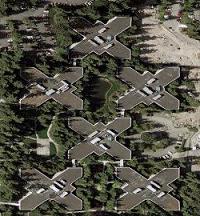Lisa spent the weekend in our front yard doing “structural landscape improvements” (meaning pulling nasty hedges out by the roots), while I helped uproot some of the stumps while reversing the last bit of damage done to the house when we moved the fridge in.
First, the hedges: with such a small front yard, we decided it didn’t make sense to devote a lot of it to hedges—particularly to hedges that grow like weeds and lose all their leaves in a spectacularly ugly fashion in winter. So last weekend Lisa took a variety of pruning tools to them and cut them down to a few inches above the ground. This was a weekend’s worth of work in itself, particularly the part where we had to bag all the cuttings. Then on Friday Lisa took a day off and started digging the roots out. Almost all the hedges had taproots that were a foot long or more and several inches in diameter, which were impossible to dig out with shovels and very difficult to sever. Fortunately our neighbors stopped by and said, “We have a crowbar that might help you out.” Thanks, said Lisa, but we already have one. “Not like this you don’t,” said our neighbor, and came back with a five-foot-long solid iron bar that had to be about seventy years old. It was cylindrical at one end, but tapered to a rectangular form at the other end with a pyramidal tip. I had never heard of using a prybar for gardening, but it’s apparently a standard item in Roger Cook’s toolkit. I’ll upload a picture later.
With the prybar in hand, Lisa was able to lever out all the taproots unaided, leaving nothing but a few smaller, easily-extractable roots behind. I helped with some of the bigger root balls and did disposal work, but all in all the job went extraordinarily smoothly, which was good because I had other tasks to do.
I spent Saturday sanding the first coat of joint compound I had previously applied over the bare frame and drywall of our kitchen doorway, then applying a second skim coat. I was worried about making a mess with the sanding, but I found a useful ShopVac attachment that kept the dust from getting out of hand. I primed most of the new wall surface on Sunday, but I need to go back and make one more pass on one side where the compound didn’t smooth out the tape. Fixing the doorway left just one problem—the ceiling over the fridge.
Over the last few months we’ve kept looking at the gaping holes in the ceiling over the fridge (regular readers will remember we discovered them when I pulled down a cabinet to make room for the fridge). We had thought about putting up a patch, but after the pain of working with the backing board on the doorway we started contemplating other approaches. Late last week Lisa asked, “Why don’t we just re-mount the cabinet?” and I had to admit it seemed like the best approach. Unfortunately I needed to make the cabinet about an inch shorter, and I only had about 5/8ths of an inch extra trim above the top and below the bottom of the cabinet. So out came the Sawzall, which I used to trim a half inch from the top and the bottom of the cabinet. It was tight—in one or two places I accidentally planed a little off the top of the cabinet—but in the end it got it done. Then Lisa and I put the cabinet on a dolly and rolled it up and into the kitchen via our porch. The last step was the hardest, essentially a clean-and-jerk from the dolly straight up to the top of the fridge, but the cabinet made it and is now resting up there until I can re-secure it to the studs.
I dream of having a kitchen in which the Sawzall has no place. I think it will be a while before we’re there.

